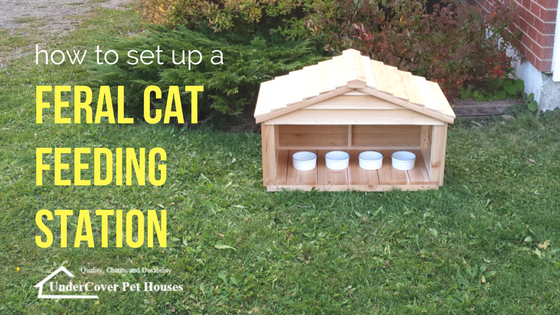 Loading... Please wait...
Loading... Please wait...How to Set Up a Feral Cat Feeding Station
Posted by Danny MacDonald on 2017 Sep 14th

Are you feeding the feral cats in your community?
Whether you are new to helping feral cats or a seasoned expert, here are 5 simple tips to help you set up a first-class feeding station.
1) Get the right feeding station.
To help your cats’ food stay clean and dry, you will need to get a pet food station. The ideal station is waterproof, easily accessible, and big enough to shelter your cat in harsh weather.
Although you can use a small dog house, they are probably not the best choice. They can only fit a few cats at a time. If one cat is inside eating, she may be startled by another cat coming in, which can cause a fight.
What does SMU’s Feral Cat Group recommend for the best cat feeding station? “Large, Rubbermaid-type tubs make excellent shelters for bowls of food and water. Or, you can get fancy with more permanent wooden shelters.”
If you want a permanent shelter, you can buy a ready-made feeding station. Available in 3 different sizes, our handcrafted feeding stations make feeding your feral cats easy and fuss-free!
2) Choose appropriate feeding dishes.
First, consider the aesthetic of your station. If it’s located in an outdoor green space, choose colors that will blend into the environment, such as brown, green, and tan. Avoid colors that will clash with the surroundings, like neons and bright colours. Purchase dishes in dark, subdued, or neutral colors.
Next, consider what type of dish would be appropriate. Some feral cat volunteers use paper plates or plastic meat trays. Although these are a cheap and easy option, they may not be the best choice. After the cats eat the food, they tend to blow away and litter the area. If you are not diligent about picking them up, they may cause complaints from neighbours.
Other options include using the bottom of a brown paper grocery bag or a gravity dry-food dispenser. However, we recommend using a plastic or metal dish. They are widely used, easy to clean, and durable. #bestinclass
Shopping for an outdoor cat shelter? Take a look at our handcrafted cat houses!
3) Provide fresh water daily.
Since your cats also need to stay hydrated, include water in your outdoor cat feeding station. In the colder months, you will need to ensure that the water doesn’t freeze over. Check out this helpful article on how to keep your cats’ water from freezing.
Change the water every day to prevent algae scum, and monitor how much your cats drink. If you are concerned that your cats are not drinking enough water, try these tips to help them stay hydrated.
4) Establish a regular routine.
For feral cats, the best times to feed are at dawn or dusk. At these times, they are most active and ready to eat. Once you choose a time, feed them at the same time every day.
At Trinity University, the Cat Alliance provides food for feral cats year round, with both students, faculty, and volunteers helping out.
If possible, it is best to leave the food out for 30 minutes until all the cats eat. While they eat, observe from a short distance away. Write down the number of cats, their approximate ages, if any are ear tipped, etc. Then, pick up the food bowls so as not to attract other wildlife. Note how much food the cats ate.
As you get to know the colony, do a headcount every day. Watch for signs of illness or health issues. If they have a runny nose, a matted coat, or sudden weight loss, you may need to take them to the vet.
It’s also important to get your cats neutered and spayed as soon as possible. With a Trap-Neuter Return program, you can help your feral cats live a long, happy life.
